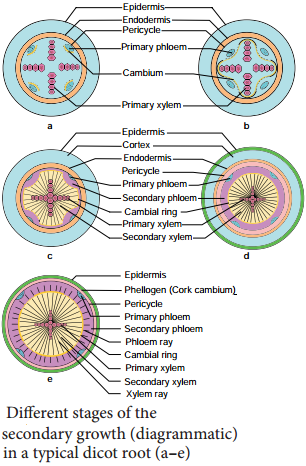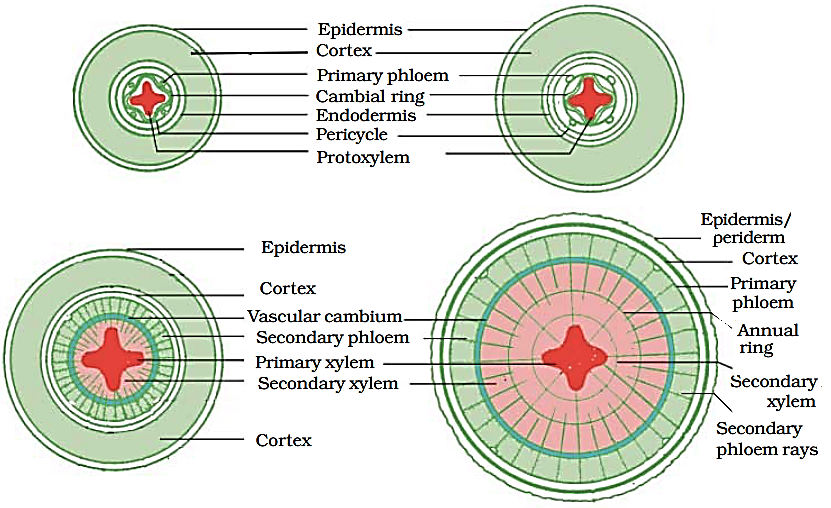Table of Contents
Secondary Growth in Dicot Stem & Root Notes
This article we will discuss about Secondary Growth in Dicot Stem & Root Notes
- By the activity of lateral meristems, formation of secondary tissue which leads to increase in girth is called secondary growth
- Two types of lateral meristems involved in secondary growth:- vascular cambium and cork cambium
- Secondary growth takes place in root and stem of dicotyledons and gymnosperms
- Secondary growth in stellar region due to activity of the vascular cambium
- Secondary growth in extra stellar region due to activity of cork cambium
Secondary Growth in Dicot Stem
Secondary growth in stelar region by vascular cambium
Formation of cambium ring
- Cambium is present between xylem and phloem. It is known as intrafascicular cambium
- During secondary growth, some cells of medullary rays become active and form a strip of cambium in between vascular bundles called interfascicular cambium
- Both the intrafascicular and interfascicular cambium unite together to form a complete ring called the cambium ring
- Two types of cells are found in cambial ring:- fusiform initials & ray initials
Activity of cambial ring
I) Fusiform initials
- Numerous cells formed towards the centre and periphery regions
- Cells in centre mature into secondary xylem & cells in periphery mature into the secondary phloem
- Secondary xylem is formed 8-10 times more as compared to secondary phloem
II) Ray initials
- It’s give rise to parenchyma cells is called secondary medullary rays
- Development of vascular rays are both centripetal and centrifugal
- They conduct water and food in radial direction
Formation of annual rings
- Activity of cambium is affected by variations in temperature
In spring season
- Vascular cambium is very active and produces large number of secondary xylem
- Secondary xylem elements having vessels with wider cavities
- Wood formed during this season is called spring wood or early wood
- Spring wood is lighter in colour and has lower density
In autumn season
- Vascular cambium is less active and forms fewer secondary xylem
- Secondary xylem elements having vessels with narrow cavities
- Wood formed during this season is called autumn wood or late wood
- Autumn wood is darker in colour and has higher density
- Ring of autumn wood & spring wood are collectively known as annual ring
- The number of annual rings formed in a tree give the idea of age of the tree
- The study of determination of age of a tree is called dendrochronology
- Clear annual rings are not formed in India except Himalayan regions
Formation of heart wood and sap wood
- In old trees where sufficient amount of secondary growth has taken place
the secondary wood of inner side lose the power of conduction - Their cells get filled with tannins, resins, gums, essential oils
- These cells makes the plant part hard and darker called the heart wood or duramen
- Heart wood ceases the function of conducting tissue and simply provides mechanical support
- The outer region of secondary wood, which consists of younger living xylem cells, remains yellow in colour called the sap wood or laburnum
- It functions as the conducting tissue and also as the food storage tissue
Secondary growth in extra stellar region by cork cambium
- Cork cambium is also known as phellogen or extrastelar cambium
- Cork cambium is develops from cortex by dedifferentiation
- It’s form new cells towards outside and towards inside
- Those cells which are formed towards outside, become suberized.
- These cells become dead cells are known as cork or phellem
- Those cells which are formed inside, are differentiated into parenchyma. These are called secondary cortex or phelloderm
- Phellem, phellogen and phelloderm are collectively known as periderm
- Cork cambium is more active towards outside, cork is formed in high quantity and secondary cortex is less quantity
- At certain regions, the cork cambium cuts off and forms parenchymatous cells on outer side instead of cork cells
- These parenchymatous cells are not suberized. These cells are called complementary cells
- Complementary cells increase in number, pressure is exerted on the epidermis due to which it ruptures, forming lens shaped openings is called lenticels & Its helps exchange of gases and transpiration
Secondary growth in dicot root
- Secondary growth in dicot roots is essential to provide strength
- It is similar to secondary growth in dicot stem
- However, there is marked difference is manner of the formation of vascular cambium
Origin and activity of vascular cambium
- Vascular cambium is completely secondary in origin
- It originates from conjunctive tissue located just below the phloem and as a portion of pericycle tissue present above the protoxylem
- Its form a complete and continuous wavy ring
- This wavy ring produces secondary xylem and secondary phloem similar to the secondary growth in stems
Origin and activity of cork cambium
- Cork cambium is developed from pericycle in roots
- Cork is formed towards the outside and secondary cortex is formed towards inner side by the cork cambium
- Lenticels are also found in roots but less in number
- Clear annual rings are not seen in root because root are not affected by the changes of environment
- In dicot roots all cambia and pith rays are secondary in origin
For more detailed information about plant anatomy, download now full study material as PDF

